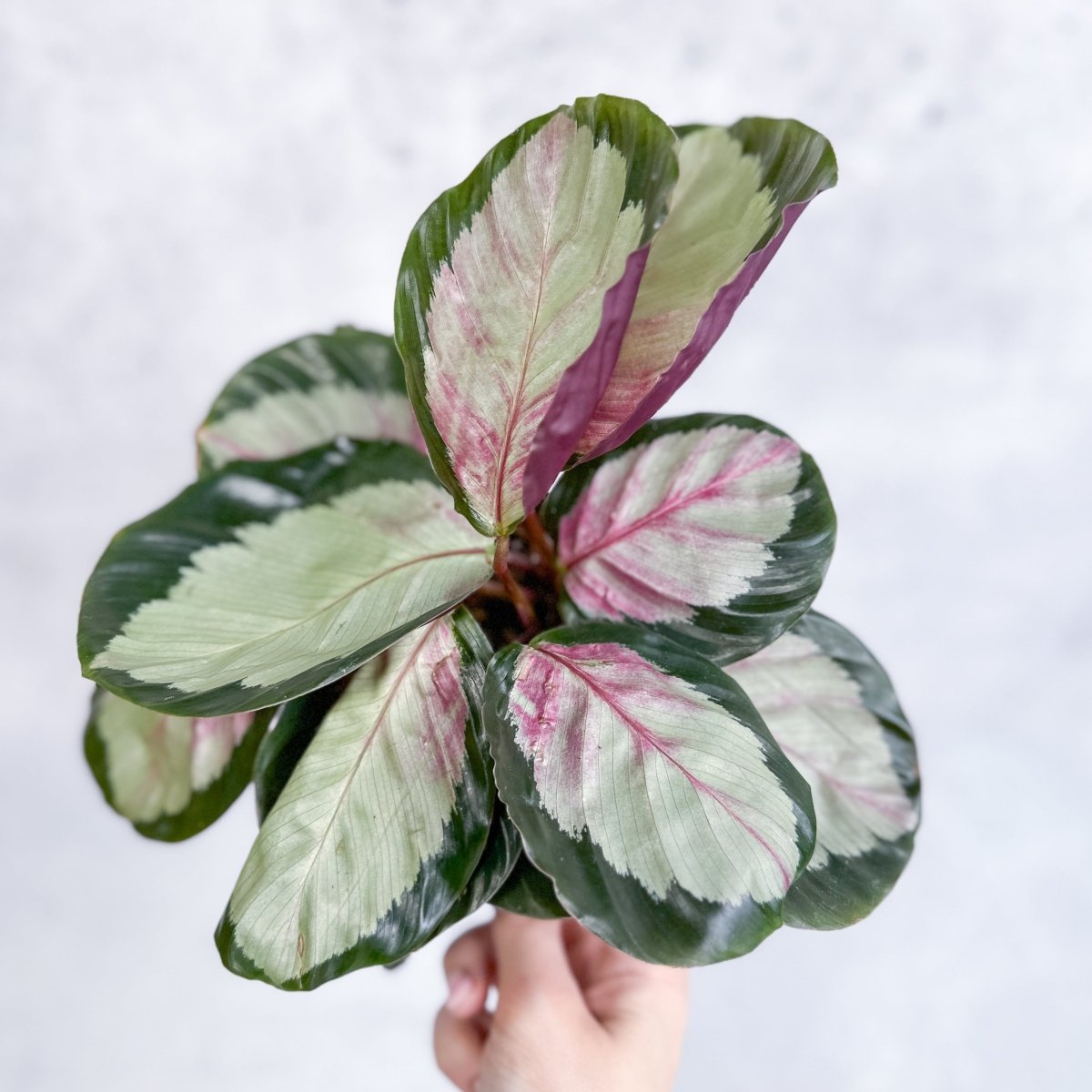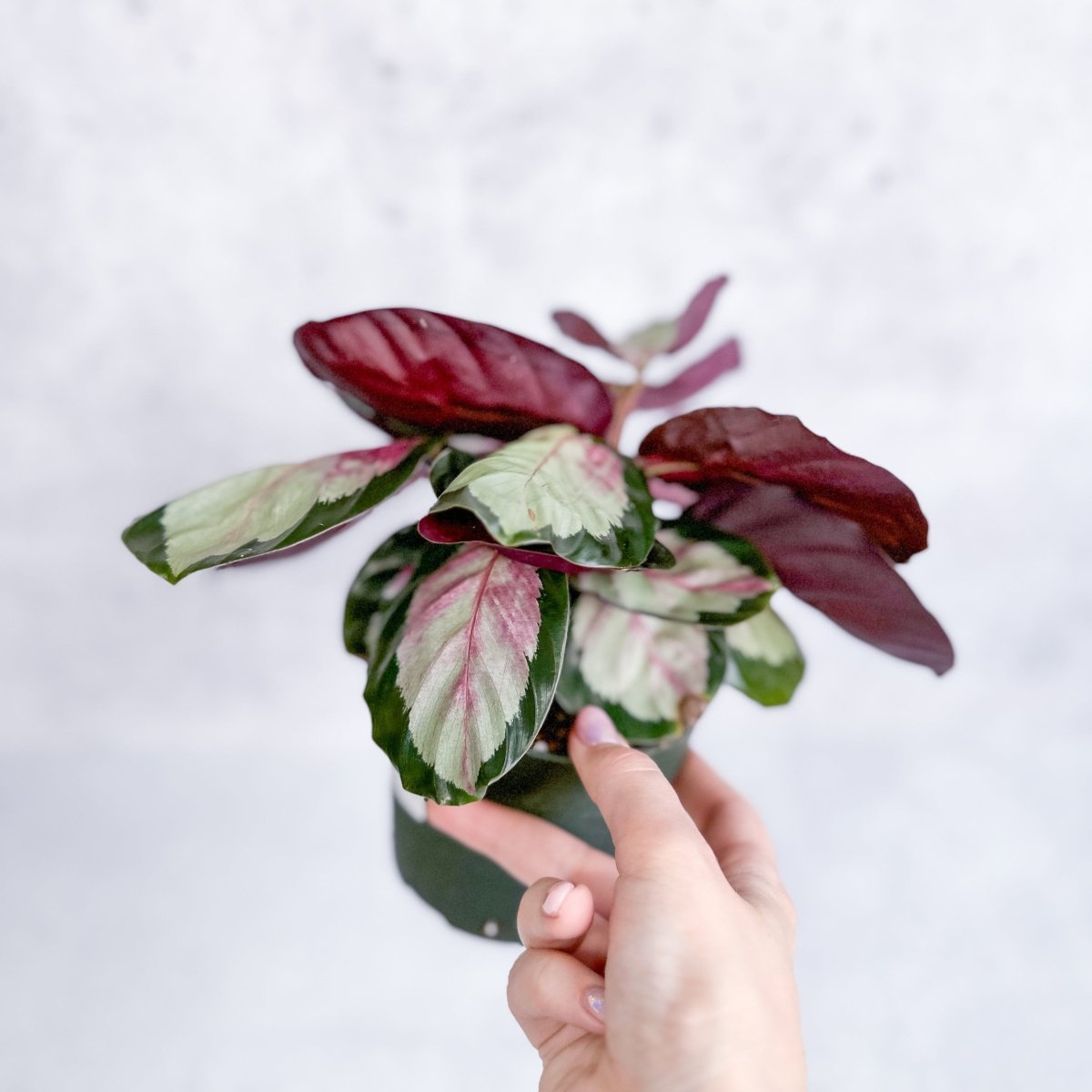Calathea 'Rosy' - Rosy Calathea
Calathea 'Rosy' - Rosy Calathea - 6" Nursery Pot is backordered and will ship as soon as it is back in stock.
Couldn't load pickup availability
Description
Description
A Touch of Elegance with the Rosy Calathea
The Rosy Calathea, with its captivating and distinctive foliage, is the epitome of botanical elegance. Featuring deep green leaves adorned with striking pink stripes, this houseplant adds a touch of sophisticated charm to any interior space. Renowned for its air-purifying qualities, the Rosy Calathea not only enchants with its aesthetic appeal but also enhances the air quality in your home.
Calathea 'Rosy' Plant Profile
- Botanical Name: Calathea
- Common Name: Rosy Calathea, Rosy Plant
- Family: Marantaceae
- Native Range: Tropical Americas
Calathea 'Rosy' Care Guide
- Care Level: Moderate
- Light Preference: Medium Light, Low/Shade, Bright/Indirect
-
Water Frequency: High/Moist. Thrives in evenly moist, well-drained soil. Allow the surface of the soil to slightly dry out between watering. These plants can be sensitive to hard water or water that has too many additives. We recommend using filtered tap water or rain water
- Humidity Preference: High
- Temperature: Prefers warmth; 60-85F
- Soil Type: Regular potting mix, Peaty mix, Airy and slightly acidic
- Pruning: Prune as needed to remove brown or dead leaves
- Feeding: Fertilize every couple of weeks with a diluted balanced fertilizer during spring and summer
- Propagation: Root division
- Growth Habit: Upright, Bushy. Can grow up to 2' tall and generally prefers to be repotted every two years
- Toxicity: Non-toxic to humans and pets. However, with all plants we recommend you exercise caution with children and pets
Want More In-Depth Calathea Care Tips?
We've put together a comprehensive Calathea care guide chock full of watering tips, fertilization tricks and other troubleshooting advice. Head on over to our Advanced Calathea Care Guide here.
Fun Calathea Fact: A Pink Striped Wonder
The Rosy Calathea’s vibrant pink stripes aren’t just for show—they can actually change intensity based on the plant's light exposure and overall health, making it a living mood ring for your home.
Historical Calathea Highlight: A Plant with Ancient Roots
Calatheas, including the Rosy variety, have been revered for centuries in their native tropical Americas, where indigenous people used their large, patterned leaves to wrap food and craft intricate baskets.
Did you know:
Bottom watering is best for Calathea? Check our our guide on how to bottom water Calathea plants and more on comprehensive blog about bottom watering.
Looking for houseplants that are safe for your furry friends? Check out our Guide to pet-friendly plants and learn how to create a vibrant, pet-safe space today!
Keep Your Plants Cozy with Heat Packs
Frequently Asked Questions
Shipping
How do you ship your plants?
How do you ship your plants?
We carefully package each plant with love by hand right from our shop in Brooklyn. Extra steps are taken to ensure that every leaf arrives in pristine shape by using polyfill and encapsulating the plant in a protective paper sleeve. The soil is also hydrated before shipping so that the plant has plenty of water for it's travel to your doorstep. We offer several shipping speeds, so please choose the one that you feel comfortable with depending on your location.
Will my plant look like the one on the website?
Will my plant look like the one on the website?
Awesome question, we're glad you asked. Given the nature of our plant shop, we're constantly moving plants in and out of the shop, making it difficult and borderline impossible to keep an exact picture of each plant. In addition to the constantly rotating crop, we often grow in batches of 6, 12, or sometimes more! With this quantity we are unable to take a photo of each and every plant. The photos that we attach to each product listing is going to be of a plant that represents the average size and fullness of that set of plants. Some may be slightly larger or smaller, but in general, similar.
Do you include heat packs with your plants?
Do you include heat packs with your plants?
We offer Heat Packs for sale separately from the plants in 40, 60 and 72 hour increments. Please add a heat pack or two to your order if you live in an area where your order may be affected during transit by cold temperatures. We are not responsible for orders that are placed and damage is incurred to the plant if a heat pack is not purchased.
Which heat pack should I choose?
Which heat pack should I choose?
Heat packs come in three different increments, so please choose the appropriate hour increment depending on the speed of shipping that you choose during checkout. For example, if you choose a cheaper shipping option that will take longer, please select the 72 hour heat pack. If you've chosen a shorter method of shipping, the 40 or 60 hour increment would work! We like to encourage our customers to always get more than you need, just to be on the safe side!
How long will it take to receive my order?
How long will it take to receive my order?
Standard shipping normally takes 3-5 days. Next day shipping is available on all domestic orders (for an additional charge). International shipping times depend on the products and destination (estimated at checkout).
Do you offer express shipping?
Do you offer express shipping?
All orders are shipped 5-8 business days from the date it is placed. Please note that as a small plant shop, we do everything in our power to get orders out as fast as we can in the order that they come in. If you have circumstances that require expedited fulfillment, please connect with you and we can potentially offer options.
What countries do you ship to?
What countries do you ship to?
We ship our selection of rare, healthy, and unique houseplants all across the United States including California. At this time, due to customs and agricultural limitations, we are unable to ship plants internationally from the United States.
Returns and Refunds
How do I return a product?
How do I return a product?
Items must be returned within 30 days after receiving your order. Items must be returned in the same condition in which they were received, be unworn/unused, have any tags still attached, and include all the original packaging.
How long will it take to receive my refund?
How long will it take to receive my refund?
Refunds are processed within 7 days from when we receive the item(s).
What should I do if my plant arrives in poor shape?
What should I do if my plant arrives in poor shape?
In the extremely unlikely event that your plant arrives in less than perfect condition, you're covered by our 15-day plant health guarantee. Simply snap a photo of your plant and send it over to us. We'll happily take a peek and offer suggestions on how to perk it back up, offer a store credit, or send a replacement. We like to make it as easy as possible!
Can I return or exchange a plant?
Can I return or exchange a plant?
At this time, we do not accept returns on plants. In extreme circumstances where a return of a plant is necessary, the customer is responsible for the return shipping and a refund will only be issued if the plant arrives back to us in living condition.











